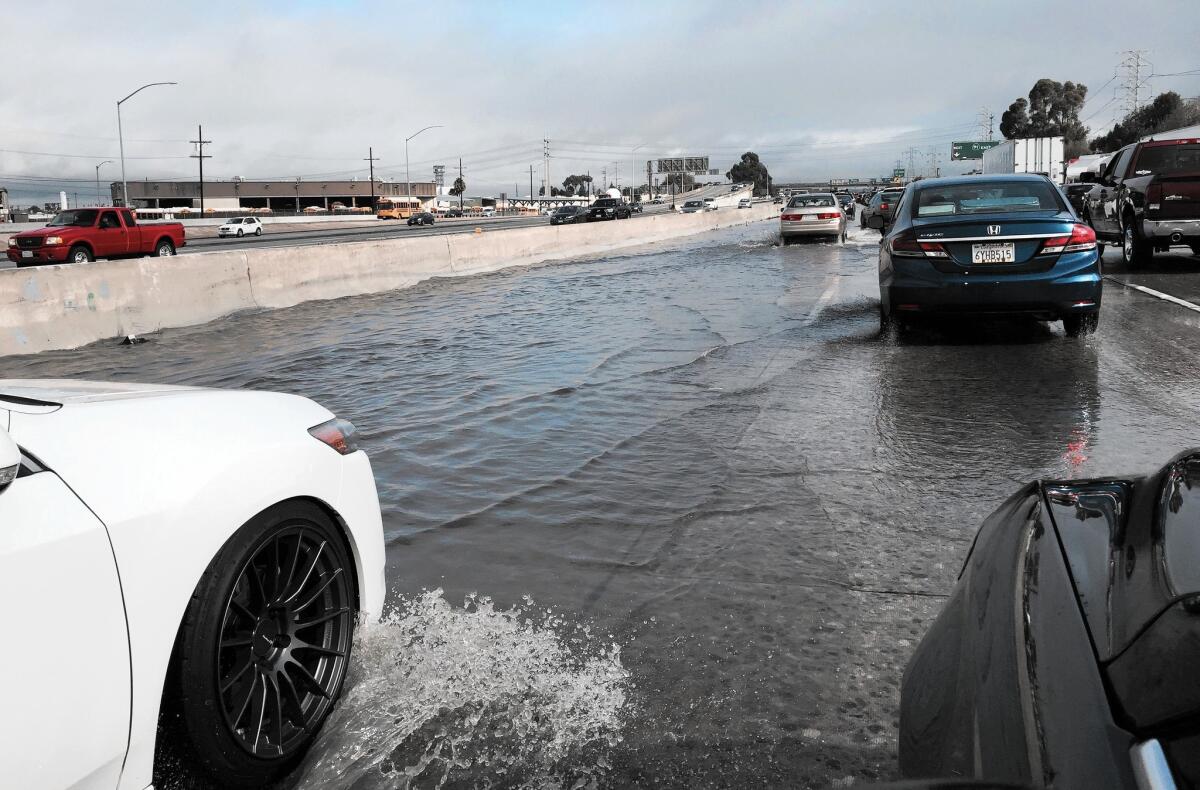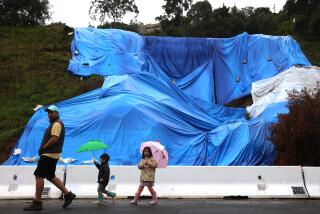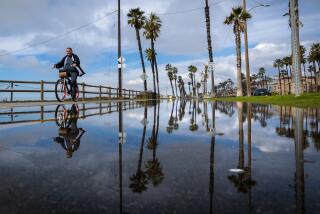Southland rain could be preview of the coming El Niño winter, experts say

It swamped streets, spilled into buildings, sent mud in motion and roiled rivers where rescue crews aided those swept up in the water overflow.
Then the downpour that stunned the drought-weary Southland with its intensity slunk off in the sun.
But if experts are right, the deluge offered a preview for the wet El Niño winter ahead.
The storm dumped more than two inches of rain on downtown Los Angeles, Santa Monica, Alhambra and other areas in just a few hours. That made it the third-wettest storm for a September in downtown L.A. since the late 1870s, said Bill Patzert, a climatologist with the Jet Propulsion Laboratory.
Tuesday’s deluge was similar to a classic El Niño storm in that it dumped large amounts of rain over a relatively small period of time. The storm hit the Los Angeles Basin hardest, with mountains, inland valleys and desert areas generally seeing less rain.
Patzert said El Niño will look like Tuesday’s downpour except it will be “more widespread, more continuous. Like a conveyor belt.”
National Weather Service forecaster Robbie Munroe said that Tuesday’s rain was from remnants of Hurricane Linda, which dissipated in the Pacific some time ago.
Linda was born out of the ocean warming trend El Niño creates, which encourages bigger, more frequent tropical storms in the Pacific, Munroe said.
Thanks to unusually warm waters off the West Coast, El Niño-fed storms are able to reach farther north and west toward Southern California than in past years, Munroe said.
Forecasters have been saying Southern California is facing a major El Niño this winter, one that could be on par with the epic 1997-98 storm season.
Strong El Niños develop when a subtropical jet stream that ferries wet storms over the jungles of southern Mexico and Central America moves northward, putting a train of storms over Southern California and the southern United States.
During the 1997-98 event, a relentless series of storms flooded roads, caused huge mudslides and overflowed flood control channels. In the end, 17 people died and the storm caused more than half a billion dollars in damage in California alone. The toll was far worse in Mexico, where Tijuana and other cities faced crippling flooding.
To put Tuesday’s rain in perspective, look to February 1998, when the effects of El Niño peaked. That month, downtown L.A. saw 13.68 inches of rain — almost a year’s worth — making it the wettest February on record.
The National Weather Service predicts a 95% chance of El Niño continuing throughout the winter.
Extraordinary attention has been paid to El Niño’s development this summer because many see it as savior to a desiccated landscape where explosive wildfires rage in relentless heat.
But officials warn that although rainfall would be a reprieve, there is virtually no hope that one rainy winter could reverse the severe effects of a four-year drought. It would take years of above-average rain and snow to end the water shortage and refill empty reservoirs and wells.
And with torrents of rain come other natural disasters, especially for regions where blazes have denuded hillsides and felled already dehydrated trees. Residents who once feared fire will soon face the threat of mudslides and debris flow.
Public works officials across the region are now working to clear debris basins that collect mudflows during big floods as well as making sure storm drains are working properly.
Although experts say El Niño is already in effect, some are cautious about how strong it will be this winter.
For a very strong El Niño to strike, the east-to-west trade winds of the Pacific Ocean along the equator need to collapse, and that hasn’t happened yet.
Such a collapse would help fuel a warming of water west of Peru, which causes changes in the atmosphere. That can shift the path of winter storms and target California.
Experts say the next few months will reveal whether El Niño will be a strong finisher, or fall short.
“There’s still some drama here, the curtain has not fallen,” Patzert said. “I’m holding off on my apocalyptic rainfall forecast until I see what happens here in the next three months.”
He likened tracking El Niño to understanding a soap opera in which the plot continuously thickens, or watching a marathon runner.
“At 20 miles, do you hit the wall? Or do you pick up the pace?”
The effects of heavy rain within a short time period were seen Tuesday as cities scrambled to respond to what would be a record day. An astonishing 2.4 inches of rain fell by the afternoon in downtown Los Angeles, an area that usually gets about 0.22 inches for the entire month of September.
Thousands of Los Angeles residents lost power and dozens of residents of a West Hollywood assisted-living center were forced to evacuate after water leaked through the roof.
Car accidents jammed freeways and countless commuters found themselves delayed on slick roads. Pacific Coast Highway in Newport Beach was shut down, as was a portion of the 710 Freeway after its water pumps fizzled out. Buses were thrown off schedule. A murder trial was put on hold as it waited for a late juror.
Three fishermen and a handful of others were rescued from the quickly rising Los Angeles, San Gabriel and Santa Ana rivers. A garage partially collapsed, sending debris down the Rubio Wash in the San Gabriel area.
Several mudflow incidents were reported in Orange County’s Silverado Canyon, which has experienced brush fires. One hillside gave out and buried a road.
Water and Power is The Times’ guide to the drought. Sign up to get the free newsletter >>
By Tuesday afternoon, the sky had cleared in Echo Park, where customers lingered at Square One at the Boathouse cafe.
Paris Yavuz, 27, had manned the counter that morning with shoes wet from the walk to work. He got a kick out of customers who entered bundled in warm clothing and ordered hot drinks.
Outside, Ohio-born Joe Hartman, 57, said he couldn’t complain about the much-needed rain and was amused by local reactions to inclement weather.
The two pit bulls he’s watching for a friend, however, are native Angelenos. They usually bolt outside when Hartman opens the door for them. On Tuesday, they stared at him and went to lie down.
Times staff writers Hailey Branson-Potts, Veronica Rocha, Ruben Vives, Brittny Mejia, Christine Mai-Duc, Marisa Gerber and Hector Becerra contributed to this report.
ALSO:
Trump zeroes in on immigration in speech aboard battleship
Valley fire among the most destructive in California history
Patients scarred, insurance firms duped in massive scam, L.A. County prosecutors say
More to Read
Sign up for Essential California
The most important California stories and recommendations in your inbox every morning.
You may occasionally receive promotional content from the Los Angeles Times.













